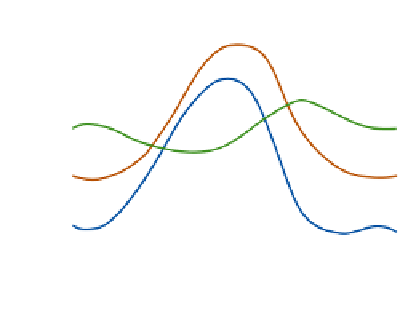Geoscience Reference
In-Depth Information
glaciers, tundra; boreal forests and steppe, all of
which are snow-covered during the long winter.
Similar energy balances characterize the winter
months (
Figure 12.6
). An exception is the local
areas of ocean covered by thin sea ice and open
leads in the ice have 300W m
-2
available - more
than the net radiation for boreal forests in
summer. The spring transition on land is very
rapid (see
Figure 10.38
). During the summer,
when albedo becomes a critical surface parameter,
there are important spatial contrasts. In summer,
the radiation budget of sea ice more than 3 meters
thick is quite low and for ablating glaciers is lower
still. Melting snow involves the additional energy
balance component (
800
600
R
n
400
H+LE
200
0
Δ
W
-200
-400
00
04
08
12
Hour
16
20
24
Figure 12.5
Average diurnal variation of the
energy balance components in and above the
tropical Atlantic Ocean during the period 20 June to
2 July 1969.
Source: After Holland. From Oke (1987). By permission of
Routledge and Methuen, London, and T. R. Oke.
M
), which is the net latent
heat storage change (positive) due to melting
Δ
SUMMER
SUMMER
R
n
HLE GM
68
R
n
HLE GM
15
163
78
22
2
8
Spruce forest
Snow-free summer
Permafrost. 60°N
G+M
18
106
41
34
20
17
14
1
2
Coastal tundra
Snow-free summer
Permafrost. 71°N
0
9
68
24
9
55
Glacier ablation zone
Summer snow
and ice. 69°N
9
73
6
7
61
29
15
Thick sea ice
Summer snow
and ice
Arctic Ocean
0
0
G+M
14
Figure 12.6
Energy balances (Wm
-2
) over four terrain types in the polar regions. M = energy used to melt snow.
Source: Weller and Wendler (1990). Reprinted from Annals of Glaciologywith the permission of the International Glaciological Society.




















































